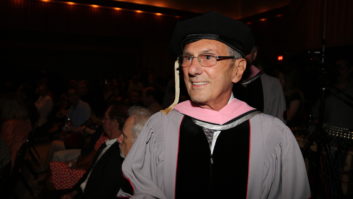
“Tommy made the artist feel so comfortable,” says celebrated engineer Al Schmitt when discussing his longtime friend and studio collaborator, the late producer Tommy LiPuma.
“All the musicians loved Tommy. With him, it was all about the music. There was no ego. All that crap got out of the way. It was about getting the music; getting the groove. Tommy was a master of that and there was no one better. Everyone loved working with Tommy.”
Beginning with Dave Mason’s 1972 LP, Alone Together, Schmitt and LiPuma worked together on more than 100 recordings, including George Benson’s Breezin’ , Bill Evans’ You Must Believe in Spring and Natalie Cole’s Unforgettable… with Love, Paul McCartney’s Kisses on the Bottom and ao many more. The magical production duo also recorded many of Diana Krall’s million-selling albums, including When I Look In Your Eyes, The Look of Love, and LiPuma’s final work, Krall’s latest standards-filled outing Turn up the Quiet.

The recipient of 22 Grammy Awards, Schmitt considers Turn Up The Quiet to be one of his and LiPuma’s best projects.
“It was like back in the old days in the way we recorded,” Schmitt says. “With great material, great musicians, and it was all about getting the right feel in the studio. We made Diana feel at ease. We didn’t get in her way. We’ve recorded 111 albums together—Tommy and me. We didn’t talk much. He always let me do my thing and he did his. He didn’t have to worry about what was going on in the booth. He just worried about getting the content down. And it was remarkable.”
Noting Krall’s preference for tracking vocals and pia.no live with the musicians, Schmitt recorded and mixed at 192k via Capitol’s Neve 88RS 72-input console, with very lit.tle post-production editing.
“The Neumann U47 sound.ed fantastic on Diana,” Schmitt says. “It’s my go-to vocal mic, the same one Sinatra used on his Capitol records. I placed it about five or six inches from Diana. I also used a Neve 1073 preamplifier and just a touch of my Fairchild 660 compressor for the warmth of its tubes, compressed a dB or two. I ran Diana’s voice through Capitol Echo Chamber #4, blended with my Bricasti Design [Model 7 Stereo] reverb to get the sound that I want.”
Schmitt covered Krall’s custom-ordered Steinway grand with two Neumann M 149 mics, touched lightly with a Thermionic Culture Vulture Phoenix compressor. Each M 149 was placed a foot above the piano: one over the hammers, one over the instrument’s lower half.
“Diana sings softly, and she plays piano reasonably soft,” Schmitt explains. “She’s not a banger. We got a nice blend and tried to separate the piano from the voice as much as possible. We used a sleeve that fits over the piano. The sleeve has two holes where the microphones go in; that gives us separation between her vocal and piano, keeping the two clear and distinct, somewhat, not 100 percent.”
On Turn up the Quiet, as he did many other sessions, LiPuma worked with the musicians in the live room, wearing headphones to hear what they heard.
“Tommy didn’t press a button and talk through the glass,” Schmitt says. “He loved to be with the musicians. He didn’t worry about how things were sounding because he knew I was taking care of that. He concentrated on what he wanted to do.
“Tommy would say that if his ass started shaking then he knew the record was in the pocket,” Schmitt adds. “When he started dancing, you knew you were in the groove. Tommy was one of a kind; a very special human being. He was kind and giving and knew what he was doing in the studio and what he was trying to get out of the artist. And he did that in such a nice and easygoing way. There was never any friction; sessions always ran smoothly. Tommy was amazing. We won’t have another one like him.”







